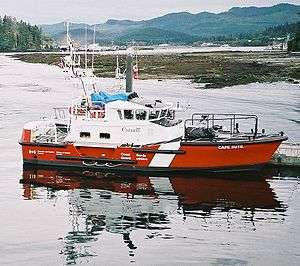CCGS Cape Discovery
 CCGS Cape Sutil at Port Hardy | |
| History | |
|---|---|
| Name: | Cape Discovery |
| Namesake: | Cape Discovery |
| Operator: | Canadian Coast Guard |
| Port of registry: | Ottawa, Ontario |
| Builder: | Victoria Shipyards Limited, Victoria, BC |
| Yard number: | 826714 |
| Christened: | 2004 |
| Homeport: | CCG Base Amherstburg, ON - Central and Arctic Region |
| Status: | in active service |
| General characteristics | |
| Class and type: | Cape Class lifeboat |
| Type: | SAR Lifeboat |
| Tonnage: |
|
| Length: | 14.6 m (47 ft 11 in) |
| Beam: | 4.27 m (14 ft 0 in) |
| Draft: | 1.37 m (4 ft 6 in) |
| Propulsion: | 2 × diesel electric engines, 675 kW |
| Speed: | 22 knots (41 km/h) cruise |
| Range: | 200 nmi (370 km) |
| Endurance: | 1 day |
| Complement: | 4 |
The CCGS Cape Discovery is one of the Canadian Coast Guard's 36 Cape class motor life boat.[1][2]` She is stationed at Goderich, Ontario. At the vessel's official christening, on June 10, 2006, the Minister of Fisheries and Oceans Canada, Loyola Hearn, said:[1] "Having this state-of-the-art vessel for our personnel provides them with greater safety, as they aid those in distress -- very often in conditions that put their own lives at risk. With the cutter Cape Discovery, we are well positioned to respond to emergency calls, twenty-four hours a day, seven days a week."
Design
Like all Cape-class motor lifeboats, Cape Discovery has a displacement of 20 short tons (18 t) and a total length of 47 feet 11 inches (14.61 m) and a beam length of 14 feet (4.3 m).[3] Constructed from marine-grade aluminium, it has a draught length of 4 feet 6 inches (1.37 m). It contains two computer-operated Detroit DDEC-III 6V-92TA diesel engines providing a combined 870 shaft horsepower. It has two 28 by 36 inches (710 mm × 910 mm) four-blade propellers, and its complement is four crew members and five passengers.[3]
The lifeboat has a maximum speed of 25 knots (46 km/h; 29 mph) and a cruising speed of 22 knots (25 mph). Cape-class lifeboats have fuel capacities of 400 US gallons (1,500 l; 330 imp gal) and ranges of 200 nautical miles (370 km; 230 mi) when cruising.[3] Cape Discovery is capable of operating at wind speeds of 50 knots (93 km/h; 58 mph) and wave heights of 30 feet (9.1 m). It can tow ships with displacements of up to 150 tonnes (170 short tons) and can withstand 60 knots (110 km/h; 69 mph) winds and 20 feet (6.1 m)-high breaking waves.[3]
Communication options include Raytheon 152 HF-SSB and Motorola Spectra 9000 VHF50W radios, and a Raytheon RAY 430 loudhailer system.[3] The boat also supports the Simrad TD-L1550 VHF-FM radio direction finder. Raytheon provides a number of other electronic systems for the lifeboat, including the RAYCHART 620, the ST 30 heading indicator and ST 50 depth indicator, the NAV 398 global positioning system, a RAYPILOT 650 autopilot system, and either the R41X AN or SPS-69 radar systems.[3]
References
- 1 2 Carol Bond (2006-06-10). "Canadian Coast Guard Christens New Search and Rescue Vessel in Sarnia, Ontario". Canadian Coast Guard. Archived from the original on 2010-01-04.
- ↑ "Canadian Coast Guard on the Job". Canadian Coast Guard. 2007-11-01. Archived from the original on 2010-01-04.
That very same day, the ROC had another report concerning a gallon of paint spilled off a scaffold of a commercial vessel in Goderich harbour. The water was cold and the wind and wave conditions were favourable for recovery operations. The paint blew in against the wharf alongside the CCG Search and Rescue base. The Captain (Erin Vincent) and crew of the Cape Discovery used their ingenuity to recover the solidifying, coagulated globs of blue paint. They improvised, inventing a makeshift recovery device, fastening a sifter to a boathook with electrical tape. The majority of the paint was recovered.
- 1 2 3 4 5 6 "Motor Life Boat 47-Foot MLB: International Affairs (CG-DCO-I)". United States Coast Guard, Department of Homeland Security. 1 July 2015. Retrieved 19 August 2015.